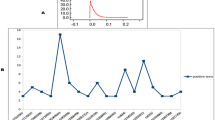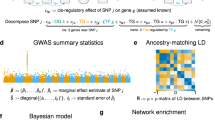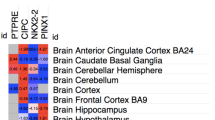Abstract
Recent genome-wide association studies (GWAS) have implicated a range of genes from discrete biological pathways in the aetiology of autism. However, despite the strong influence of genetic factors, association studies have yet to identify statistically robust, replicated major effect genes or SNPs. We apply the principle of the SNP ratio test methodology described by O’Dushlaine et al to over 2100 families from the Autism Genome Project (AGP). Using a two-stage design we examine association enrichment in 5955 unique gene-ontology classifications across four groupings based on two phenotypic and two ancestral classifications. Based on estimates from simulation we identify excess of association enrichment across all analyses. We observe enrichment in association for sets of genes involved in diverse biological processes, including pyruvate metabolism, transcription factor activation, cell-signalling and cell-cycle regulation. Both genes and processes that show enrichment have previously been examined in autistic disorders and offer biologically plausibility to these findings.
Similar content being viewed by others
Log in or create a free account to read this content
Gain free access to this article, as well as selected content from this journal and more on nature.com
or
References
Fombonne E : Epidemiology of pervasive developmental disorders. Pediatr Res 2009; 65: 591–598.
Fernell E, Gillberg C : Autism spectrum disorder diagnoses in Stockholm preschoolers. Res Dev Disabil 2010; 31: 680–685.
Bailey A, Le Couteur A, Gottesman I et al: Autism as a strongly genetic disorder: evidence from a British twin study. Psychol Med 1995; 25: 63–77.
Wang K, Zhang H, Ma D et al: Common genetic variants on 5p14.1 associate with autism spectrum disorders. Nature 2009; 459: 528–533.
Ma D, Salyakina D, Jaworski JM et al: A genome-wide association study of autism reveals a common novel risk locus at 5p14.1. Ann Hum Genet 2009; 73: 263–273.
Weiss LA, Arking DE, Daly MJ et al: A genome-wide linkage and association scan reveals novel loci for autism. Nature 2009; 461: 802–808.
Anney R, Klei L, Pinto D et al: A genome-wide scan for common alleles affecting risk for autism. Hum Mol Genet 2010; 19: 4072–4082.
Purcell SM, Wray NR, Stone JL et al: Common polygenic variation contributes to risk of schizophrenia and bipolar disorder. Nature 2009; 460: 748–752.
Holmans P, Green EK, Pahwa JS et al: Gene ontology analysis of GWA study data sets provides insights into the biology of bipolar disorder. Am J Hum Genet 2009; 85: 13–24.
Wang K, Li M, Hakonarson H : Analysing biological pathways in genome-wide association studies. Nat Rev Genet 2010; 11: 843–854.
Wang K, Li M, Bucan M : Pathway-based approaches for analysis of genomewide association studies. Am J Hum Genet 2007; 81: 1278–1283.
O’Dushlaine C, Kenny E, Heron EA et al: The SNP ratio test: pathway analysis of genome-wide association datasets. Bioinformatics 2009; 25: 2762–2763.
Lord C, Rutter M, Le Couteur A : Autism Diagnostic Interview-Revised: a revised version of a diagnostic interview for caregivers of individuals with possible pervasive developmental disorders. J Autism Dev Disord 1994; 24: 659–685.
Lord C, Rutter M, Goode S et al: Autism diagnostic observation schedule: a standardized observation of communicative and social behavior. J Autism Dev Disord 1989; 19: 185–212.
Risi S, Lord C, Gotham K et al: Combining information from multiple sources in the diagnosis of autism spectrum disorders. J Am Acad Child Adolesc Psychiatry 2006; 45: 1094–1103.
Lee AB, Luca D, Klei L et al: Discovering genetic ancestry using spectral graph theory. Genet Epidemiol 2010; 34: 51–59.
Purcell S, Neale B, Todd-Brown K et al: PLINK: a tool set for whole-genome association and population-based linkage analyses. Am J Hum Genet 2007; 81: 559–575.
Spielman RS, McGinnis RE, Ewens WJ : Transmission test for linkage disequilibrium: the insulin gene region and insulin-dependent diabetes mellitus (IDDM). Am J Hum Genet 1993; 52: 506–516.
Ashburner M, Ball CA, Blake JA et al: Gene ontology: tool for the unification of biology. The Gene Ontology Consortium. Nat Genet 2000; 25: 25–29.
Merico D, Isserlin R, Stueker O et al: Enrichment map: a network-based method for gene-set enrichment visualization and interpretation. PLoS One 2010; 5: e13984.
Shannon P, Markiel A, Ozier O et al: Cytoscape. A software environment for integrated models of biomolecular interaction networks. Genome Res 2003; 13: 2498–2504.
Ho MS, Ou C, Chan YR et al: The utility F-box for protein destruction. Cell Mol Life Sci 2008; 65: 1977–2000.
Nishimura Y, Martin CL, Vazquez-Lopez A et al: Genome-wide expression profiling of lymphoblastoid cell lines distinguishes different forms of autism and reveals shared pathways. Hum Mol Genet 2007; 16: 1682–1698.
Brown V, Jin P, Ceman S et al: Microarray identification of FMRP-associated brain mRNAs and altered mRNA translational profiles in fragile X syndrome. Cell 2001; 107: 477–487.
Haas RH : Autism and mitochondrial disease. Dev Disabil Res Rev 2010; 16: 144–153.
Serajee FJ, Nabi R, Zhong H et al: Polymorphisms in xenobiotic metabolism genes and autism. J Child Neurol 2004; 19: 413–417.
Dhillon AS, Hagan S, Rath O et al: MAP kinase signalling pathways in cancer. Oncogene 2007; 26: 3279–3290.
Bulavin DV, Fornace Jr AJ : p38 MAP kinase's emerging role as a tumor suppressor. Adv Cancer Res 2004; 92: 95–118.
Bradham C, McClay DR : p38 MAPK in development and cancer. Cell Cycle 2006; 5: 824–828.
Pinto D, Pagnamenta AT, Klei L et al: Functional impact of global rare copy number variation in autism spectrum disorders. Nature 2010; 466: 368–372.
Acknowledgements
We gratefully acknowledge the families participating in the study and the main funders of the AGP: Autism Speaks (USA), the Health Research Board (HRB, Ireland; AUT/2006/1, AUT/2006/2, PD/2006/48), The Medical Research Council (MRC, UK), Genome Canada/Ontario Genomics Institute and the Hilibrand Foundation (USA). Additional support for individual groups was provided by the US National Institutes of Health (NIH Grants: HD055751, HD055782, HD055784, MH52708, MH55284, MH061009, MH06359, MH066673, MH080647, MH081754, MH66766, NS026630, NS042165, NS049261), the Canadian Institutes for Health Research (CIHR), Assistance Publique – Hôpitaux de Paris (France), Autism Speaks UK, Canada Foundation for Innovation/Ontario Innovation Trust, Deutsche Forschungsgemeinschaft (Grant: Po 255/17-4) (Germany), EC Sixth FP AUTISM MOLGEN, Fundação Calouste Gulbenkian (Portugal), Fondation de France, Fondation FondaMental (France), Fondation Orange (France), Fondation pour la Recherche Médicale (France), Fundação para a Ciência e Tecnologia (Portugal), the Hospital for Sick Children Foundation and University of Toronto (Canada), INSERM (France), Institut Pasteur (France), the Italian Ministry of Health (convention 181 of 19 October 2001), the John P Hussman Foundation (USA), McLaughlin Centre (Canada), Ontario Ministry of Research and Innovation (Canada), the Seaver Foundation (USA), the Swedish Science Council, The Centre for Applied Genomics (Canada), the Utah Autism Foundation (USA) and the Wellcome Trust core award 075491/Z/04 (UK). DP is supported by fellowships from the Royal Netherlands Academy of Arts and Sciences (TMF/DA/5801) and the Netherlands Organization for Scientific Research (Rubicon 825.06.031). SWS holds the GlaxoSmithKline-CIHR Pathfinder Chair in Genetics and Genomics at the University of Toronto and the Hospital for Sick Children (Canada).
Author contributions
EMK and COD developed the principle of the SRT experiments. RJLA designed the study, developed and implemented the pedSRT methodology and wrote the manuscript. EMK, COD, BLY, MG and LG aided in manuscript preparation. RJLA, EMK, COD, BY, EP, JDB and JSS discussed research strategies and data through the ’pathway-based analysis working group‘. Additional intellectual support and guidance was provided through the AGP including BD, ADP, EHC, PS, JTG, CK, KW, HH and EM.
Author information
Authors and Affiliations
Consortia
Corresponding author
Ethics declarations
Competing interests
The authors declare no conflict of interest.
Additional information
The AGP Members §Member of Senior Investigator Committee for the AGP Anthony J Bailey§1, Bridget A Fernandez2, Peter Szatmari§3, Stephen W Scherer§4,5, Andrew Patterson§4, Christian R Marshall4, Dalila Pinto4, John B Vincent6, Eric Fombonne7, Catalina Betancur§8, Richard Delorme9, Marion Leboyer10, Thomas Bourgeron11, Carine Mantoulan12, Bernadette Roge12, Maïté Tauber12, Christine M Freitag§13, Fritz Poustka13, Eftichia Duketis13, Sabine M Klauck§14, Annemarie Poustka14, Katerina Papanikolaou15, John Tsiantis15, Louise Gallagher§16, Michael Gill§16, Richard Anney16, Nadia Bolshakova16, Sean Brennan16, Gillian Hughes16, Jane McGrath16, Alison Merikangas16, Sean Ennis§17, Andrew Green17, Jillian P Casey17, Judith M Conroy17, Regina Regan17, Naisha Shah17, Elena Maestrini§18, Elena Bacchelli18, Fiorella Minopoli18, Vera Stoppioni19, Agatino Battaglia§20, Roberta Igliozzi20, Barbara Parrini20, Raffaella Tancredi20, Guiomar Oliveira§21, Joana Almeida21, Frederico Duque21, Astrid Vicente§22,23,24, Catarina Correia22,23,24, Tiago R Magalhaes23, Christopher Gillberg25, Gudrun Nygren25, Maretha de Jonge26, Herman Van Engeland26, Jacob AS Vorstman26, Kerstin Wittemeyer27, Gillian Baird28, Patrick F Bolton29, Michael L Rutter30, Jonathan Green31, Janine A Lamb32, Andrew Pickles33, Jeremy R Parr34, Ann Le Couteur34, Tom Berney34, Helen McConachie34, Simon Wallace35, Marc Coutanche35, Suzanne Foley35, Kathy White35, Anthony P Monaco§36, Richard Holt36, Penny Farrar36, Alistair T Pagnamenta36, Ghazala K Mirza36, Jiannis Ragoussis36, Inês Sousa36, Nuala Sykes36, Kirsty Wing36, Joachim Hallmayer§37, Rita M Cantor§38, Stanley F Nelson38, Daniel H Geschwind§39, Brett S Abrahams39, Fred Volkmar40, Margaret A Pericak-Vance§41, Michael L Cuccaro41, John Gilbert41, Edwin H Cook§42, Stephen J Guter42, Suma Jacob42, John I Nurnberger Jr§43, Christopher J McDougle43, David J Posey43, Catherine Lord44, Christina Corsello44, Vanessa Hus44, Joseph D Buxbaum§45,46, Alexander Kolevzon46, Latha Soorya46, Elena Parkhomenko46, Bennett L Leventhal47, Geraldine Dawson48, Veronica J Vieland§49, Hakon Hakonarson§50,51, Joseph T Glessner51, Cecilia Kim, Kai Wang51, Gerard D Schellenberg§52, Bernie Devlin§53, Lamburtus Klei53, Nancy Minshew54, James S Sutcliffe§55, Jonathan L Haines§55, Sabata C Lund55, Susanne Thomson55, Brian L Yaspan55, Hilary Coon§56, Judith Miller56, William M McMahon56, Jeff Munson57, Annette Estes58, Ellen M Wijsman§59 1Department of Psychiatry, University of British Columbia, British Columbia, Canada; 2Disciplines of Genetics and Medicine, Memorial University of Newfoundland, St John's, Canada; 3Department of Psychiatry and Behavioural Neurosciences, McMaster University, Hamilton, Canada; 4The Centre for Applied Genomics and Program in Genetics and Genomic Biology, The Hospital for Sick Children, Toronto, Canada; 5Department of Molecular Genetics, University of Toronto, Toronto, Canada; 6Centre for Addiction and Mental Health, Clarke Institute and Department of Psychiatry, University of Toronto, Toronto, Canada; 7Division of Psychiatry, McGill University, Montreal, Canada; 8INSERM U952 and CNRS UMR 7224 and UPMC Univ Paris 06, Paris, France; 9INSERM U955, Fondation FondaMental, APHP, Hôpital Robert Debré, Child and Adolescent Psychiatry, Paris, France; 10INSERM U995, Department of Psychiatry, Groupe Hospitalier Henri Mondor-Albert Chenevier, AP-HP; University Paris 12, Fondation FondaMental, Crétiel, France; 11Human Genetics and Cognitive Functions, Institut Pasteur; University Paris Diderot-Paris 7, CNRS URA 2182, Fondation FondaMental, Paris, France; 12Octogone/CERPP (Centre d’Eudes et de Recherches en Psychopathologie), University de Toulouse Le Mirail, Toulouse, France; 13Department of Child and Adolescent Psychiatry, Psychosomatics and Psychotherapy, JW Goethe University Frankfurt, Frankfurt, Germany; 14Division of Molecular Genome Analysis, German Cancer Research Center (DKFZ), Heidelberg, Germany; 15University Department of Child Psychiatry, Athens University, Medical School, Agia Sophia Children's Hospital, Athens, Greece; 16Autism Genetics Group, Department of Psychiatry, School of Medicine, Trinity College, Dublin, Ireland; 17School of Medicine and Medical Science, University College, Dublin, Ireland; 18Department of Biology, University of Bologna, Bologna, Italy; 19Neuropsichiatria Infantile, Ospedale Santa Croce, Fano, Italy; 20Stella Maris Institute for Child and Adolescent Neuropsychiatry, Calambrone (Pisa), Italy; 21Hospital Pediátrico de Coimbra, Coimbra, Portugal; 22Instituto Nacional de Saude Dr Ricardo Jorge, Lisbon, Portugal; 23BioFIG – Center for Biodiversity, Functional and Integrative Genomics, Lisboa, Portugal; 24Instituto Gulbenkian de Ciência, Oeiras, Portugal; 25Gillberg Neuropsychiatry Centre, Sahlgrenska Academy, University of Gothenburg, Gothenburg, Sweden; 26Department of Child and Adolescent Psychiatry, University Medical Center, Utrecht, The Netherlands; 27Autism Centre for Education and Research, School of Education, University of Birmingham, Birmingham, UK; 28Newcomen Centre, Guy's Hospital, London, UK; 29Department of Child and Adolescent Psychiatry, Institute of Psychiatry, King's College London, London, UK; 30Social, Genetic and Developmental Psychiatry Centre, Institute of Psychiatry, King's College London, London, UK; 31Academic Department of Child Psychiatry, Booth Hall of Children's Hospital, Blackley, Manchester, UK; 32Centre for Integrated Genomic Medical Research, University of Manchester, Manchester, UK; 33Department of Medicine, School of Epidemiology and Health Science, University of Manchester, Manchester, UK; 34Institute of Neuroscience, and Institute of Health and Society, Newcastle University, Newcastle Upon Tyne, UK; 35Department of Psychiatry, University of Oxford, Warneford Hospital, Headington, UK; 36Wellcome Trust Centre for Human Genetics, University of Oxford, Oxford, UK; 37Department of Psychiatry, Division of Child and Adolescent Psychiatry and Child Development, Stanford University School of Medicine, Stanford, USA; 38Department of Human Genetics, University of California – Los Angeles School of Medicine, Los Angeles, USA; 39Program in Neurogenetics, Department of Neurology and Center for Autism Research and Treatment, Semel Institute, David Geffen School of Medicine at UCLA, Los Angeles, USA; 40Child Study Centre, Yale University, New Haven, USA; 41The John P Hussman Institute for Human Genomics, University of Miami School of Medicine, Miami, USA; 42Department of Psychiatry, Institute for Juvenile Research, University of Illinois at Chicago, Chicago, USA; 43Department of Psychiatry, Indiana University School of Medicine, Indianapolis, USA; 44Autism and Communicative Disorders Centre, University of Michigan, Ann Arbor, USA; 45Department of Genetics and Genomic Sciences and Neuroscience, Mount Sinai School of Medicine, New York, USA; 46The Seaver Autism Center for Research and Treatment and Department of Psychiatry, Mount Sinai School of Medicine, New York, USA; 47Nathan Kline Institute for Psychiatric Research (NKI), Orangeburg; Department of Child and Adolescent Psychiatry, New York University and NYU Child Study Center, New York, USA; 48Autism Speaks, New York; Department of Psychiatry, University of North Carolina, Chapel Hill, USA; 49Battelle Center for Mathematical Medicine, The Research Institute at Nationwide Children's Hospital and The Ohio State University, Columbus, USA; 50Department of Pediatrics, Children's Hospital of Philadelphia, University of Pennsylvania School of Medicine, Philadelphia, USA; 51Division of Human Genetics, The Center for Applied Genomics, The Children's Hospital of Philadelphia, Philadelphia, USA; 52Pathology and Laboratory Medicine, University of Pennsylvania, USA; 53Department of Psychiatry, University of Pittsburgh School of Medicine, Pittsburgh, USA; 54Departments of Psychiatry and Neurology, University of Pittsburgh School of Medicine, Pittsburgh, USA; 55Department of Molecular Physiology and Biophysics, and Center for Human Genetics Research, Vanderbilt University School of Medicine, Nashville, USA; 56Psychiatry Department, University of Utah Medical School, Salt Lake City, USA; 57Department of Psychiatry and Behavioural Sciences, University of Washington, Seattle, USA; 58Department of Speech and Hearing Sciences, University of Washington, Seattle, USA; 59Departments of Biostatistics and Medicine, University of Washington, Seattle, USA.
Supplementary Information accompanies the paper on European Journal of Human Genetics website
Supplementary information
Rights and permissions
About this article
Cite this article
Anney, R., Kenny, E., O'Dushlaine, C. et al. Gene-ontology enrichment analysis in two independent family-based samples highlights biologically plausible processes for autism spectrum disorders. Eur J Hum Genet 19, 1082–1089 (2011). https://doi.org/10.1038/ejhg.2011.75
Received:
Revised:
Accepted:
Published:
Issue date:
DOI: https://doi.org/10.1038/ejhg.2011.75
Keywords
This article is cited by
-
A pilot study of several environmental endocrine disrupting chemicals in children with autism spectrum disorder in south China
Environmental Monitoring and Assessment (2023)
-
Discovery of the molecular mechanisms of the novel chalcone-based Magnaporthe oryzae inhibitor C1 using transcriptomic profiling and co-expression network analysis
SpringerPlus (2016)
-
Protein signatures of oxidative stress response in a patient specific cell line model for autism
Molecular Autism (2014)
-
Mapk/Erk activation in an animal model of social deficits shows a possible link to autism
Molecular Autism (2014)
-
Biomarkers in autism spectrum disorder: the old and the new
Psychopharmacology (2014)



